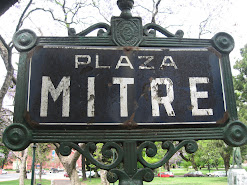In the late 19th and early 20th century Argentina was one of the world's wealthiest nations and the Alvear family was at the pinnacle of belle Buenos Aires society. In 1897 Josefina de Alvear, a niece of the city's first mayor and a cousin of President Marcelo T. Alvear, married Matias Erraturiz at the Cathedral of Buenos Aires. After many years in Europe, the family returned in 1917 and moved into their spectacular new palace on Avenida Libertador. Their French architect, Rene Sergent, designed a total of 15 projects for Argentine clients of which 5 were completed. One of the others is the former home of Josephina's sister, the Bosch-Alvear Palace, now the American Embassy residence.
While in Europe the Erraturiz-Alvears undoubtedly visited Auguste Rodin's own exhibit at the Parisian World's Fair. They later commissioned a massive fireplace from him that was never completed. A small model signed by Rodin can be viewed at the mansion which opened its doors as the Museo Nacional de Arte Decorativo in 1937. The museum features paintings and sculpture from the family's collection by El Greco, Corot, Delacroix, Fragonard and Manet. But the palacio itself is the star of the show and will be truly appreciated by those who enjoy spectacular homes from days gone by. Sergent's concept was a revival of the French neoclassical style of the 18th century and many rooms were inspired by landmark buildings in France: for example the ballroom after the Hotel Soubise and the dinning room after the Petit Trianon in Versailles. Two exceptions are the renaissance Great Hall which was designed to feature the family's existing collection of tapestries, and an excellent neobaroque sitting room by the Catalan artist Jose Maria Sert. The Sert chamber was commissioned at the request of Matias (Mato) E. Alvear, the couple's only son.
Current visitors will enjoy a bonus treat: a spectacular collection of portrait miniatures (the forerunner of the wallet photograph) now on display in the family living room. The collection includes numerous 18th century watercolor on ivory works by well known artists who specialized in miniatures. Most are framed in gold pendants and many are pocket masterpieces. Among the sitters are English, French and Russian nobility including numerous children. A very tiny painting of Nicolas V of Russia is set in a diamond encrusted ring. I enjoyed looking at all those little faces from another time and place. While some of the miniatures served political purposes and were mass-produced, others were one-of-a-kind treasures kept close to the heart on long journeys across an ocean.
A blog which may appeal to those who enjoy stories about people, politics, economics, sports, and travel. In and around Argentina and the USA.
3/20/2008
Subscribe to:
Post Comments (Atom)



























































































1 comment:
See here or here
Post a Comment